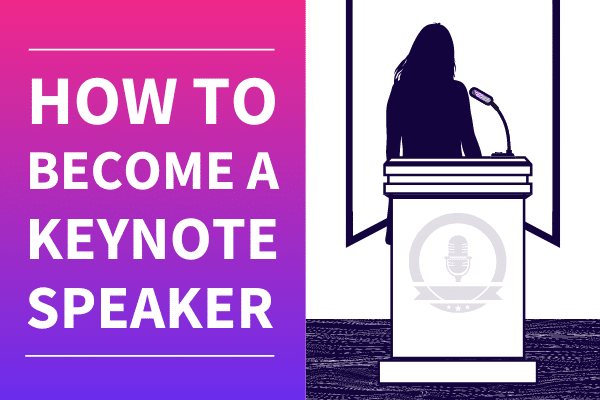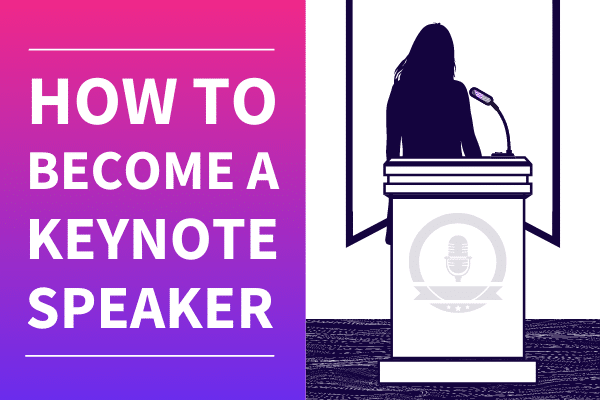To become a keynote speaker, develop expertise in a specific area and build a strong personal brand. Then, network with event organizers and create a compelling speaker proposal.
Becoming a keynote speaker is a great way to share your expertise with a wide audience and establish your thought leadership in your industry. Keynote speakers are often seen as experts in their field and are invited to speak at conferences, corporate events, and other gatherings.
If you have valuable insights and experiences to share, honing your public speaking skills and networking with event organizers can help you build a successful career as a sought-after keynote speaker. We will explore the steps you can take to become a successful keynote speaker and share your knowledge with the world.
Crafting Your Story
Unlock your potential by honing your storytelling skills to become a captivating keynote speaker. Master the art of crafting your story to engage and inspire your audience, elevating your presence on the stage. Embrace the power of your narrative to leave a lasting impact and create memorable experiences.
Identifying Your Message
Before you can craft a compelling keynote speech, it’s crucial to identify your message—the core idea or theme that you want to convey to your audience. What is the main message that you want people to take away from your speech? What knowledge, experience, or insight do you possess that can benefit others?
- Reflect on your expertise and unique experiences
- Consider what topics you are passionate about
- Research current trends and needs within your industry or niche
Creating a Compelling Narrative
Once you have identified your message, it’s time to craft a compelling narrative that will captivate your audience. A well-structured story can engage and inspire listeners, making your keynote speech memorable and impactful.
- Begin with a strong opening that grabs attention and sets the tone for your speech
- Clearly outline your main points and supporting examples to provide structure and clarity
- Use storytelling techniques such as anecdotes, personal experiences, or case studies to illustrate your message
- Include a call to action or a memorable conclusion to leave a lasting impression on your audience
Remember, the power of your keynote speech lies in your ability to connect with your audience on an emotional level. Craft a story that elicits empathy, resonates with their experiences, and motivates them to take action.

Credit: www.linkedin.com
Developing Public Speaking Skills
Mastering the art of public speaking is crucial for becoming a successful keynote speaker. This involves honing various aspects such as vocal delivery and stage presence.
Mastering Vocal Delivery
Effective vocal delivery is essential in captivating your audience. Enhance your pitch, tone, and pacing to keep listeners engaged.
Polishing Stage Presence
Your stage presence leaves a lasting impact. Work on body language, gestures, and eye contact to establish a strong connection with the audience.
Also Read: How to Become Stewardess on Yacht
Building a Strong Personal Brand
Establishing Expertise in Your Field
Consistently create high-quality content showcasing expertise in your niche.
Share valuable insights, case studies, and success stories.
Offer to speak at industry events and contribute to relevant publications.
Utilizing Social Media Effectively
Engage with followers by responding to comments and messages promptly.
Share your speaking engagements and behind-the-scenes content.
Leverage platforms like LinkedIn and Twitter for professional networking.
See Also: How to Become a Bike Mechanic
Networking and Relationship Building
Build lasting connections and expand your network to boost visibility as a keynote speaker. Prioritize authentic relationships, attend industry events, initiate meaningful conversations, and leverage social media to establish yourself as a thought leader. Networking and relationship-building are crucial to securing speaking opportunities and enhancing your influence in the industry.
Connecting with Industry Professionals
Networking plays a crucial role in becoming a sought-after keynote speaker. Building meaningful relationships with industry professionals can open doors to new opportunities and enhance your credibility. Here are some effective strategies to connect with industry professionals: – Attend conferences and industry events: Attending relevant conferences and industry events provides a platform to meet and interact with professionals who share your passion. Be proactive, approachable, and take advantage of networking opportunities during these events. – Utilize professional online platforms: Leverage the power of professional platforms like LinkedIn to connect with industry professionals. Grow your network by joining relevant groups, engaging with posts, and reaching out to potential mentors or collaborators. – Seek introductions: Don’t be afraid to ask for introductions from mutual connections or colleagues. A warm introduction can help establish a connection and increase the chances of a fruitful conversation. – Engage on social media: Actively engage with industry professionals on social media platforms like Twitter, Facebook, or Instagram. Leave thoughtful comments, share valuable content, and participate in conversations to demonstrate your expertise and build relationships.Leveraging Speaking Engagements
Securing speaking engagements can be a stepping stone to becoming a successful keynote speaker. Here are some ways to leverage these opportunities: – Deliver high-quality presentations: Every speaking engagement is an opportunity to showcase your expertise and captivate your audience. Develop compelling content, use visual aids, and hone your presentation skills to deliver memorable and inspiring talks. – Collect testimonials and referrals: After each speaking engagement, request testimonials and feedback from event organizers and attendees. Positive testimonials can help build credibility and attract future speaking opportunities. Additionally, ask for referrals to other event organizers or professionals who may require a keynote speaker. – Share insights and resources: Create value for your audience by sharing valuable insights and resources related to your expertise. This can be in the form of blog posts, industry reports, or useful tools and templates. Sharing valuable content establishes you as a thought leader and keeps your audience engaged. – Maintain an online presence: Make sure to have an updated website or blog where you can showcase your speaking engagements, testimonials, and valuable resources. Additionally, maintain an active presence on social media platforms, sharing highlights from your speaking engagements and engaging with your audience. Remember, networking and leveraging speaking engagements go hand in hand. By building strong relationships with industry professionals and making the most of speaking opportunities, you can pave the way to becoming a sought-after keynote speaker.Securing Keynote Speaking Opportunities
Securing keynote speaking opportunities is a crucial step in establishing yourself as a sought-after speaker in your niche. It’s essential to strategically research target events and organizations and effectively pitch yourself as a speaker to increase the chances of securing keynote speaking engagements.
Researching Target Events and Organizations
To secure keynote speaking opportunities, start by researching target events and organizations that align with your expertise and message. Identify industry-specific conferences, summits, and seminars where your insights can provide value. Utilize online databases, industry publications, and social media platforms to discover upcoming events and organizations that could benefit from your expertise.
Pitching Yourself as a Speaker
Once you’ve identified potential speaking opportunities, craft a compelling pitch to showcase your expertise and relevance to the event or organization. Tailor your pitch to highlight your unique perspectives and the value you can bring to the audience. Provide examples of previous speaking engagements, testimonials, or case studies that demonstrate your ability to engage and inspire audiences. Personalize your pitch for each opportunity, emphasizing how your message aligns with the event’s theme or the organization’s goals.

Credit: thought-leader.com
Delivering Impactful Presentations
When it comes to becoming a keynote speaker, delivering impactful presentations is crucial. Engaging the audience from start to finish and incorporating memorable visual aids are key to leaving a lasting impression. Let’s explore how to master these essential elements.
Engaging the Audience from Start to Finish
Engaging the audience from the beginning sets the tone for a successful presentation. Starting with a compelling story or asking thought-provoking questions can capture their attention right away. Throughout the presentation, maintain eye contact and use inclusive language to involve the audience. Encouraging interaction, such as asking for their input or opinions, can make the experience more engaging and memorable.
Incorporating Memorable Visual Aids
Memorable visual aids can significantly enhance the impact of a presentation. Utilizing powerful images and infographics can help convey key points effectively. Incorporating videos or real-life examples can make the content more relatable to the audience. Consistent branding and a professional design for visual aids can elevate the overall impression of the presentation.
Managing Logistics and Contracts
Managing logistics and contracts is an essential aspect of becoming a keynote speaker. It involves negotiating fees and terms and handling travel and accommodation arrangements. These tasks require careful attention to detail and effective communication to ensure a smooth and successful speaking engagement. Let’s explore each of these areas in more detail:
Negotiating Fees and Terms
When it comes to negotiating fees and terms as a keynote speaker, it’s crucial to have a well-defined pricing structure and clearly communicate your value to potential clients. Here are a few key points to consider:
- Research: Before entering into any negotiations, thoroughly research the market rates and industry standards for keynote speaking engagements. This will give you a solid foundation when setting your fees.
- Pricing Structure: Develop a pricing structure that reflects your expertise and the value you provide as a speaker. Consider factors such as the duration of the presentation, the audience size, and the level of customization required.
- Flexibility: While having a standard fee structure is essential, be willing to negotiate and customize your offerings based on the client’s needs and budget. This flexibility can help secure more speaking opportunities.
Handling Travel and Accommodation Arrangements
As a keynote speaker, you’ll often be required to travel to various locations to deliver your presentations. Ensuring smooth travel and accommodation arrangements is crucial for a successful event. Here are some tips to handle these logistics efficiently:
- Communication: Maintain open communication with event organizers to gather all the necessary details regarding travel dates, location, and any specific requirements.
- Travel Booking: Compare different travel options and book your flights well in advance to secure the best deals. It’s advisable to have travel insurance to minimize any unexpected disruptions.
- Accommodation: Research and book suitable accommodations close to the event venue. Consider factors such as proximity, convenience, and amenities to ensure a comfortable stay.
- Ground Transportation: Arrange for reliable transportation to and from the airport and event location. This can include hiring a car service or coordinating with event organizers for transportation.
By effectively managing logistics and contracts, you can focus on delivering an impactful keynote presentation while ensuring a seamless experience for both yourself and the event organizers. Remember, attention to detail and clear communication are key to establishing yourself as a successful keynote speaker.

Credit: speakerflow.com
Measuring Success and Seeking Feedback
Tracking success as a keynote speaker is essential for growth. Seeking feedback allows for constant improvement.
Evaluating Audience Response
Feedback from the audience provides valuable insights for future presentations.
- Analyze body language and engagement levels.
- Review post-event surveys for constructive criticism.
- Consider audience questions and discussions as indicators of interest.
Continuous Improvement and Adaptation
Adapting to the audience’s needs ensures relevance and engagement.
- Focus on refining content based on feedback received.
- Stay updated with industry trends and incorporate relevant information.
- Regularly practice and refine presentation skills.
Conclusion
Becoming a keynote speaker requires a combination of passion, preparation, and perseverance. By honing your speaking skills, building a strong personal brand, and leveraging your network, you can position yourself as an authority in your field. Remember to continually refine your message and adapt to the needs of your audience.
With dedication and determination, you can pave your own path to becoming a successful keynote speaker.
